Introduction
Ever-changing consumer behaviors and disruptive technologies are constantly pushing businesses to innovate. As new inventions take shape, companies’ patent lists are getting longer, and the number of patents a firm owns has become a signifier of advancement.
In this report, we examine Amazon’s patent repository and analyze how the e-commerce giant stacks up against some of its competitors and other innovators in terms of patents. While Amazon is primarily positioned as an e-commerce firm, its patents and R&D spending distinguish it as more a technology firm than retailer. To illustrate Amazon’s scale of innovation, we compare the number of patents the company has received with the number received by other firms that are well known for their innovations. First, though, we take a look at what patents are and how they work in the US.
A Patents Primer
Businesses are continually trying to differentiate their offering from those of their competitors in order to capture consumers and market share. One way for companies to retain their competitive advantage is to patent the technologies, products and processes they use to deliver their customer proposition.
A patent is an exclusive right to an invention, granted by a federal or intergovernmental organization to an inventor or assignee (such as a company or university). Patents are territorial rights, meaning they are applicable only in the region or country where they are filed and granted.
The time it takes for a patent application to be reviewed and granted (if found worthy) varies based on the technology or product involved. According to the latest data from the United States Patent and Trademark Office (USPTO), which is for the year ended September 30, 2017, the average length of time between a patent being filed and the USTPO’s first action on it was 16.3 months. The total average pendency (the length of time between the filing and the office’s decision to issue or abandon the patent) was 24.2 months. The USPTO also publishes statistics for patents that fall within selected technology families, and these show that applications related to communication had the shortest total average pendency among technology patent applications, of 21.7 months. Patents related to mechanical engineering, manufacturing and products had the longest total average pendency, of 28.9 months.
According to the US Patent Act, patent applicants are required to publish their application 18 months after first filing it, unless they have chosen to publish it earlier. Under certain circumstances, applicants may be exempted from the publication requirement and permitted to keep their application confidential.
Amazon Is Among the Top-Ranked Companies in Terms of Number of Patents Owned
Amazon owned 7,096 US patents as of January 23, 2018, according to the USPTO. That figure includes only patents granted to Amazon Technologies, Inc., and Amazon.com, Inc. Mentions of Amazon patents in this report refer exclusively to those filed by or granted to these two entities, unless otherwise indicated. If we were to include patents issued to Amazon’s subsidiaries and recently acquired firms, the numbers would be higher.
In addition to patents granted, Amazon Technologies, Inc., had filed and published 870 patent applications in the US as of January 23, 2018, and Amazon.com, Inc., had filed and published 16 patent applications.
For several years now, Amazon has ranked as one of the top companies in terms of number of patents granted to it by the USPTO in a single year. As shown below, Amazon Technologies, Inc., was among the top 20 firms in terms of number of patents granted in 2017. Amazon has been gradually moving away from filing patents under Amazon.com, Inc., and in 2017, that business entity was granted only one patent in the US.
It is noteworthy that Amazon is the only company in the group shown in the graph below that has a major interest in the retail sector; the rest are primarily technology companies and automobile manufacturers. In 2017, Amazon Technologies, Inc., moved a notch higher on the list of 20 companies, to 13th place, having received 1,983 patents during the year.
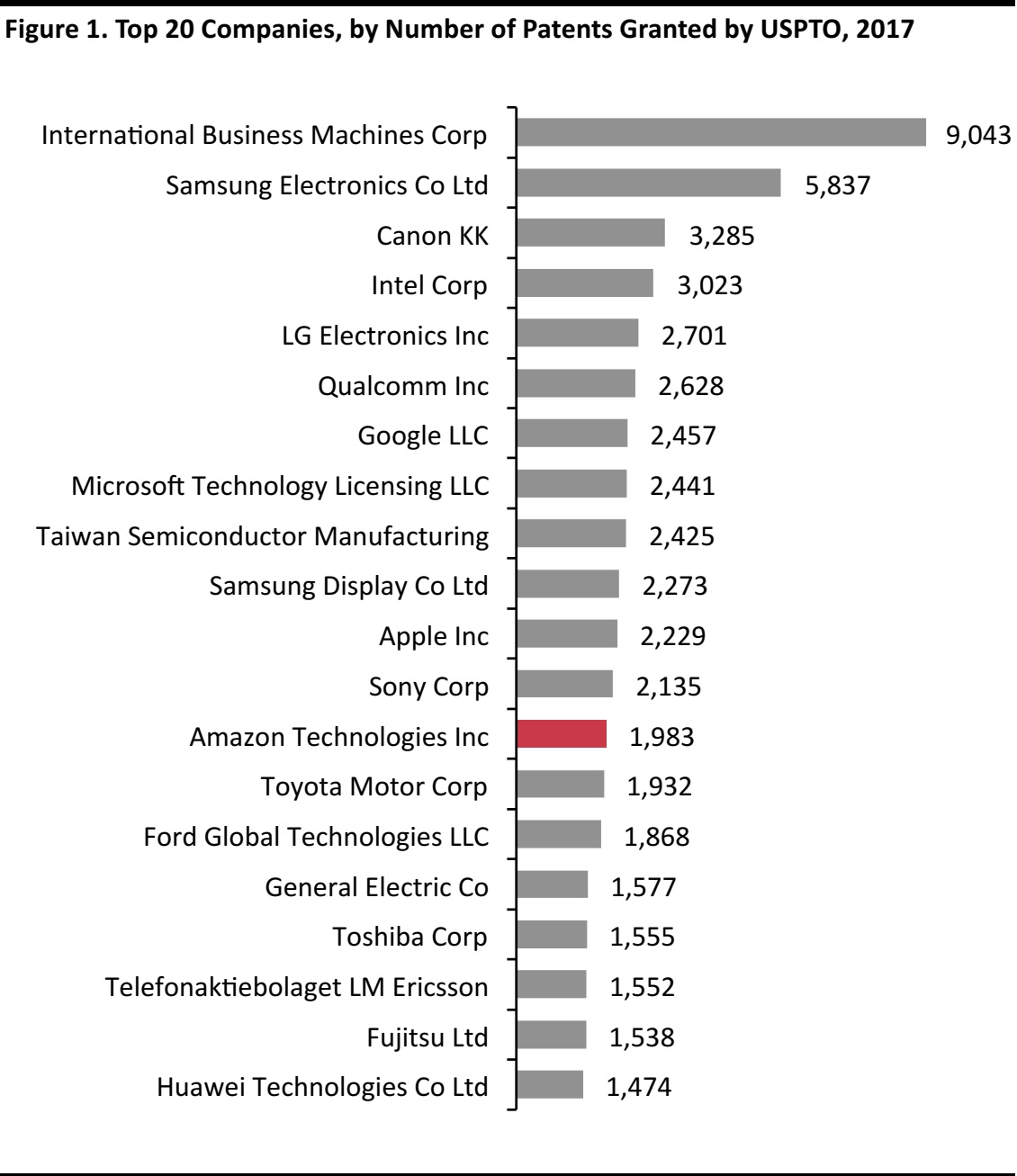 As of January 1, 2018
Source: IFI Claims Patent Services/USPTO
As of January 1, 2018
Source: IFI Claims Patent Services/USPTO
Amazon’s Focus on Innovation Sets It Apart from Other Retailers
Amazon CEO Jeff Bezos runs the company on an aggressive “Day 1” philosophy that calls for treating each day as if it were the firm’s first. The philosophy emphasizes constant innovation and learning and the embracing of external trends—and it is likely what has driven Amazon to outclass other retailers as well as many technology companies.
Amazon Holds More Patents than Other Retailers
Amazon delivers its offerings predominantly through technology, so it is unsurprising that the company invests more in creating digital tools and processes than does the average retailer that has both a physical and online presence.
According to the USPTO, as of January 23, 2018:
- Amazon held 7,096 patents under Amazon Technologies, Inc., and Amazon.com, Inc.
- Walmart held 349 patents under Wal-Mart Stores, Inc., and two under Walmart Stores, Inc.
- Macy’s held three patents under Macy’s West Stores, Inc.
- Alibaba Group held 440 patents under Alibaba Group Holding Limited.
- eBay held 1,438 patents under eBay, Inc.
Walmart and Macy’s primarily operate through physical stores and use online stores and other technology to supplement the delivery of their offering. But technology is crucial to the operations of Internet companies such as Alibaba and eBay, which both own more patents than Walmart does but also both own fewer than Amazon does.
Globally, Amazon owned about 10,400 patents as of January 22, 2018, while Alibaba owned more than 8,200 and JD.com about 1,100, according to data from the World Intellectual Property Organization.
Amazon Holds Numerous Patents Related to Emerging Technologies
Amazon not only holds the most patents among retailers, but also competes closely with the world’s leading technology companies in terms of developing and patenting technologies.
For the below table, we have considered US patents only. Among the world’s leading technology companies, IBM holds the most US patents as well as the most US patents related to emerging technology. Amazon holds fewer US patents than IBM, Microsoft, Google and Apple each do, but it has outpaced Apple with regard to emerging-technology patents. Facebook lags the other companies shown in terms of total patents held as well as in terms of patents held in most emerging-technology categories.
 As of January 22, 2018
Source: USPTO
As of January 22, 2018
Source: USPTO
Amazon Is the Biggest Spender on R&D
Amazon’s determination to develop cutting-edge technology is evidenced by the resources it dedicates to R&D. The company invested $16.1 billion in R&D in 2017, according to data from Bloomberg and S&P Capital IQ, making it the world’s biggest spender on R&D last year. Many other top-ranked companies on this metric are in sectors unrelated to retail, such as information technology, pharmaceuticals and automobile manufacturing.
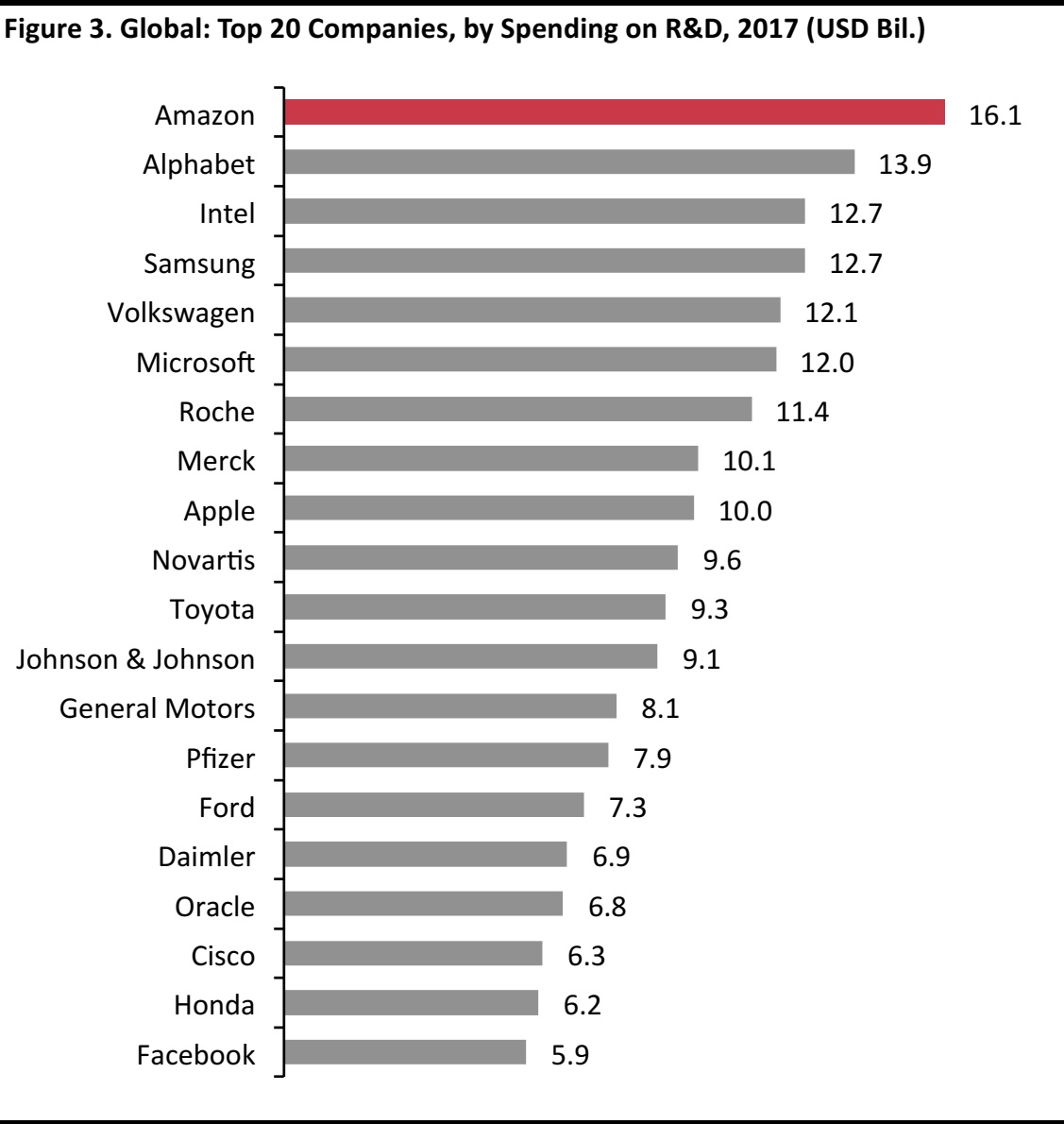 Source: Bloomberg/S&P Capital IQ
Source: Bloomberg/S&P Capital IQ
Amazon’s Notable Patents
Amazon has been granted patents for thousands of inventions spanning one-click buying, drones, virtual-reality mirrors and Alexa, the company’s artificial intelligence–powered voice assistant. Below, we highlight some of Amazon’s recent notable innovations.
Airborne Fulfillment Center
Amazon was granted a patent in December 2016 for an airborne fulfillment center (AFC), a warehouse that would float about 45,000 feet above ground. Drones would collect products that have been ordered by customers from the AFC and then deliver them to customers before returning to make further deliveries. Smaller aircraft would be used to refuel and restock the AFC.
Amazon has also patented an idea for mobile drone delivery fulfillment centers. The drone maintenance pods would look like shipping containers and could be loaded onto ships, trucks and trains in order to serve areas with high demand for certain products. Drones would fly to the mobile hubs, while the hubs are in transit, and pick products for delivery.
 Source: Amazon/USPTO
Source: Amazon/USPTO
3D Manufacturing on Demand
Amazon was granted a patent for a “vendor interface for item delivery via 3D manufacturing on demand” on January 2, 2018. According to Amazon, this invention would help vendors selling on an online marketplace who face cost and storage challenges while stocking products and are unable to fulfill orders quickly. The system is designed to receive requests for items that need to be manufactured. Users could also provide 3D-manufacturing instructions and delivery instructions as well as choose the specific machine to carry out the order based on the instructions provided.
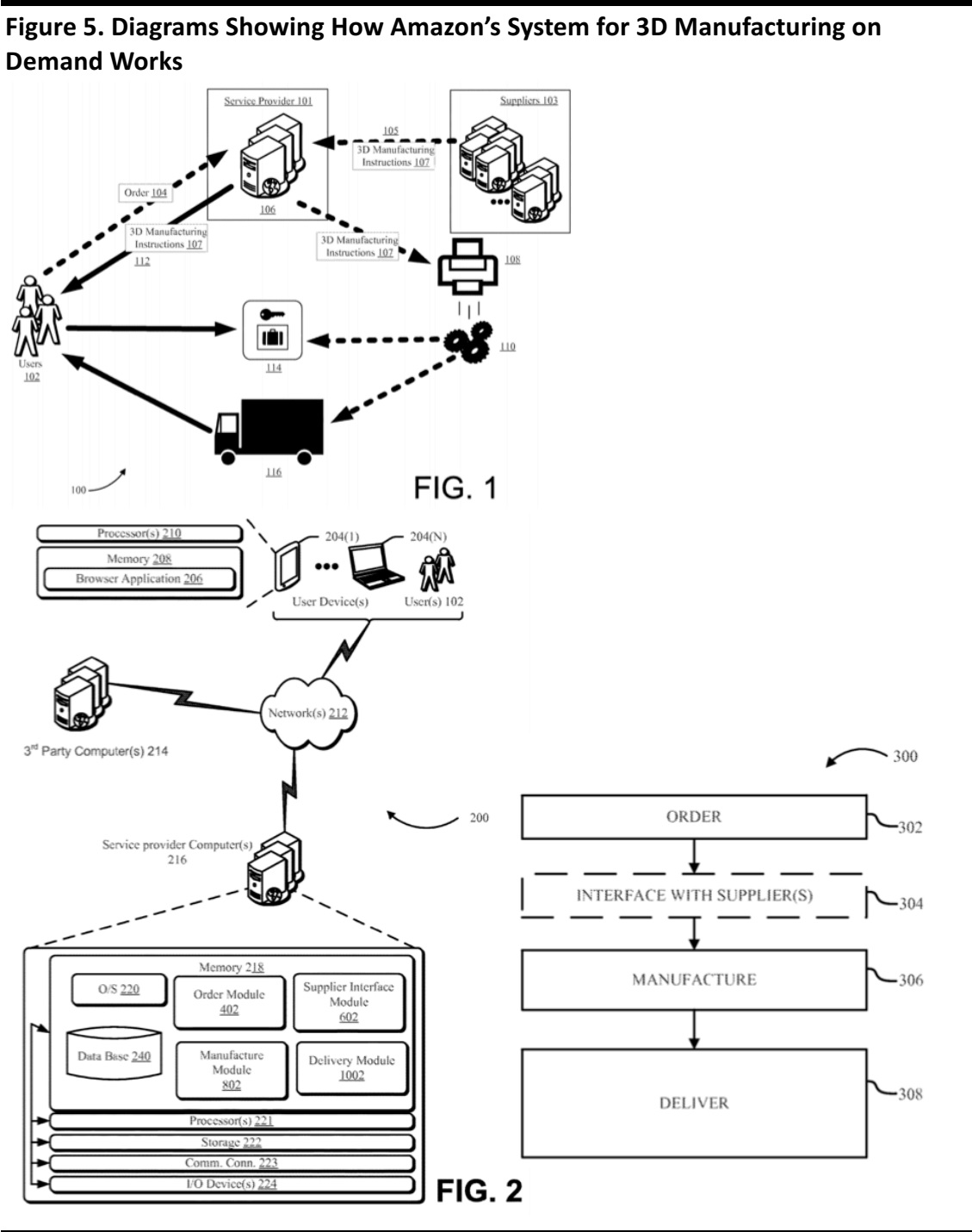 Source: Amazon/USPTO
Source: Amazon/USPTO
Blended-Reality Mirror and Automated Fabric-Cutting and Assembly Technique
Two recently patented inventions signal Amazon’s growing ambitions in the fashion space. The first is a blended-reality mirror that uses a combination of cameras, mirrors, projectors and lights to allow a user to try on virtual clothes in a virtual setting. The mirror works by projecting various clothes and backgrounds onto the user. The USPTO granted Amazon a patent for the mirror on January 2, 2018.
 Source: Amazon/USPTO
Source: Amazon/USPTO
Another patent, granted to Amazon on January 16, 2018, is for a technique that uses fluorescent ink to mark fabric and guide machines to cut, assemble and sew clothes. The ink is invisible under normal light, but can be seen under ultraviolet light. So, the reflection of the ink can be captured by image sensors to create an outline of where the fabric should be cut. The patent states that the reflective ink outlines “can also be used as assembly notations for reference by sewing workers or automated sewing systems.”
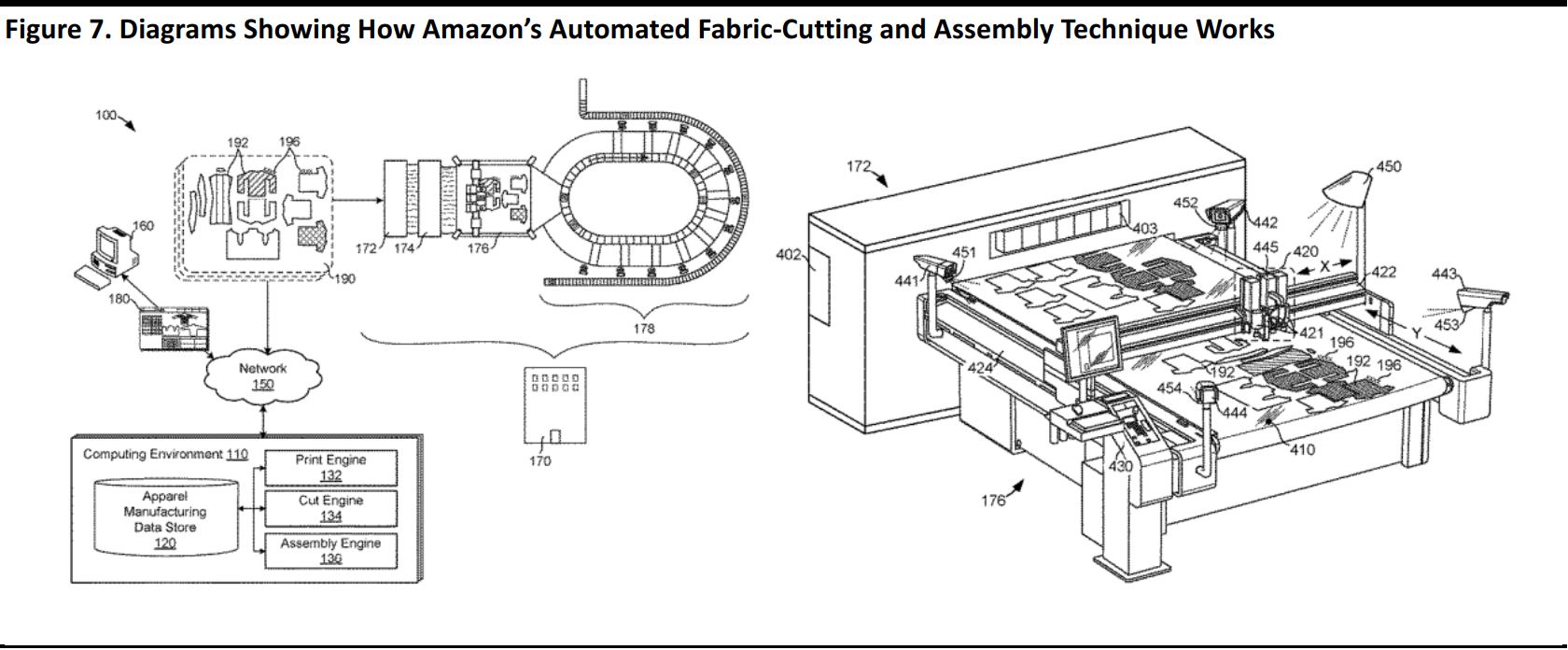 Source: Amazon/USPTO
Source: Amazon/USPTO
Voice-Controlled Light Switches
On November 21, 2017, Amazon was granted a patent for voice-controlled light switches for lights that can be used for illumination or in connection with other devices such as home appliances, factory machinery, healthcare devices (such as insulin pumps) or “any other device that receives electrical power.” Amazon notes in its patent filing that these switches may include physical switches that have voice-controlled end points and that they can be used to selectively provide power to devices—either to switch them on or off or place them “along a spectrum of positions,” meaning that they can dim lights to a required degree or provide time-delay instructions for a washing machine.
Amazon may have initially sought to use its voice-controlled Echo device to corner the smart home market, but it appears that the company is working on an ecosystem of voice-controlled devices that can be used around the house.
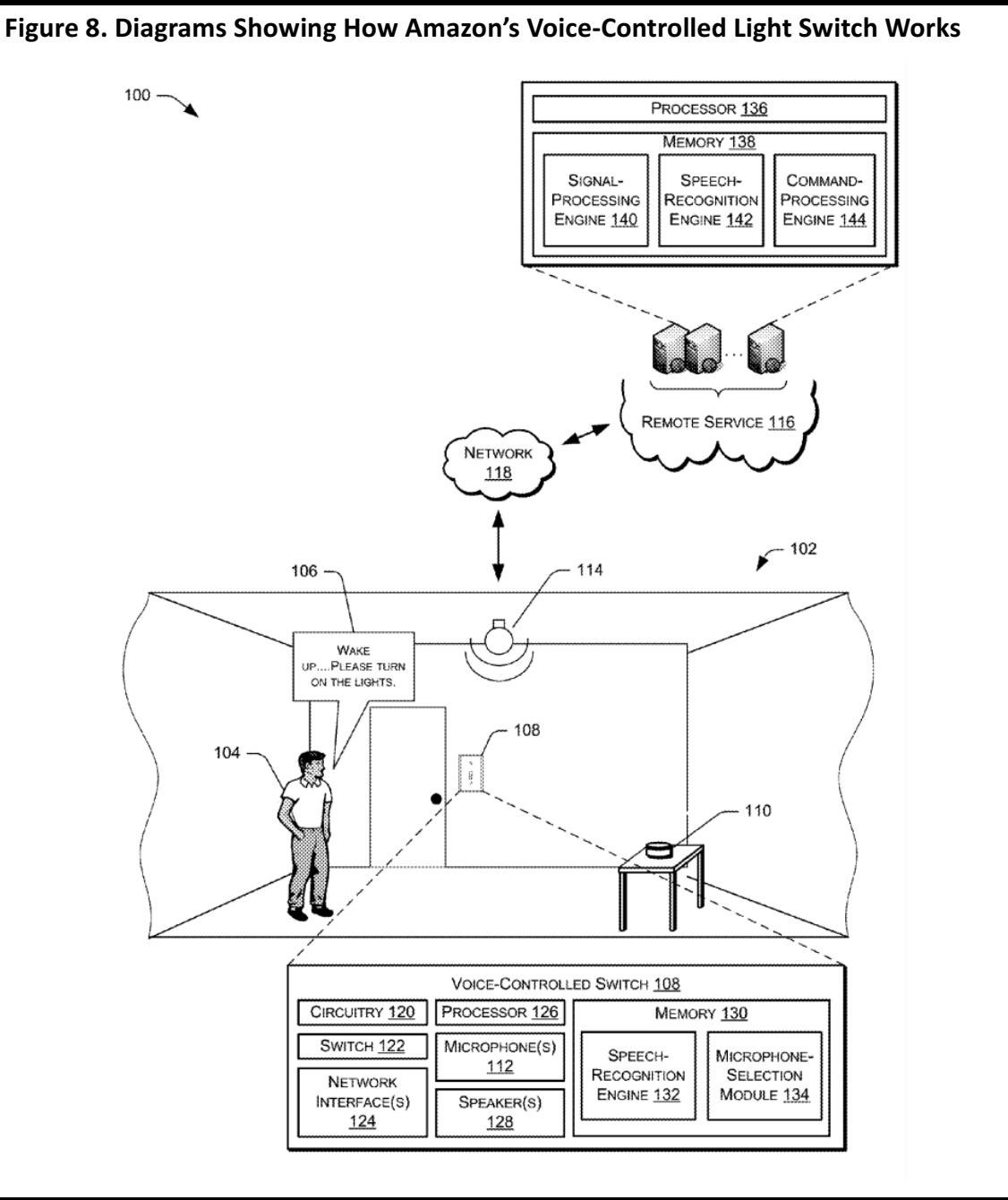 Source: Amazon/USPTO
Source: Amazon/USPTO
Technology for Hand and Hand-Pose Detection
Voice-recognition and face-recognition technologies have seen huge advances in recent years, but Amazon has recently gone one step further, patenting a technique for hand and hand-pose detection on augmented-reality devices. This technology allows for detection of hand poses that would be used to signal various commands to a machine.
Amazon was granted this patent on January 16, 2018, and in the patent description, the company justifies a need for this invention by stating that people are increasingly consuming digital content and that “this population expects digital content to become more and more accessible and ubiquitous.”
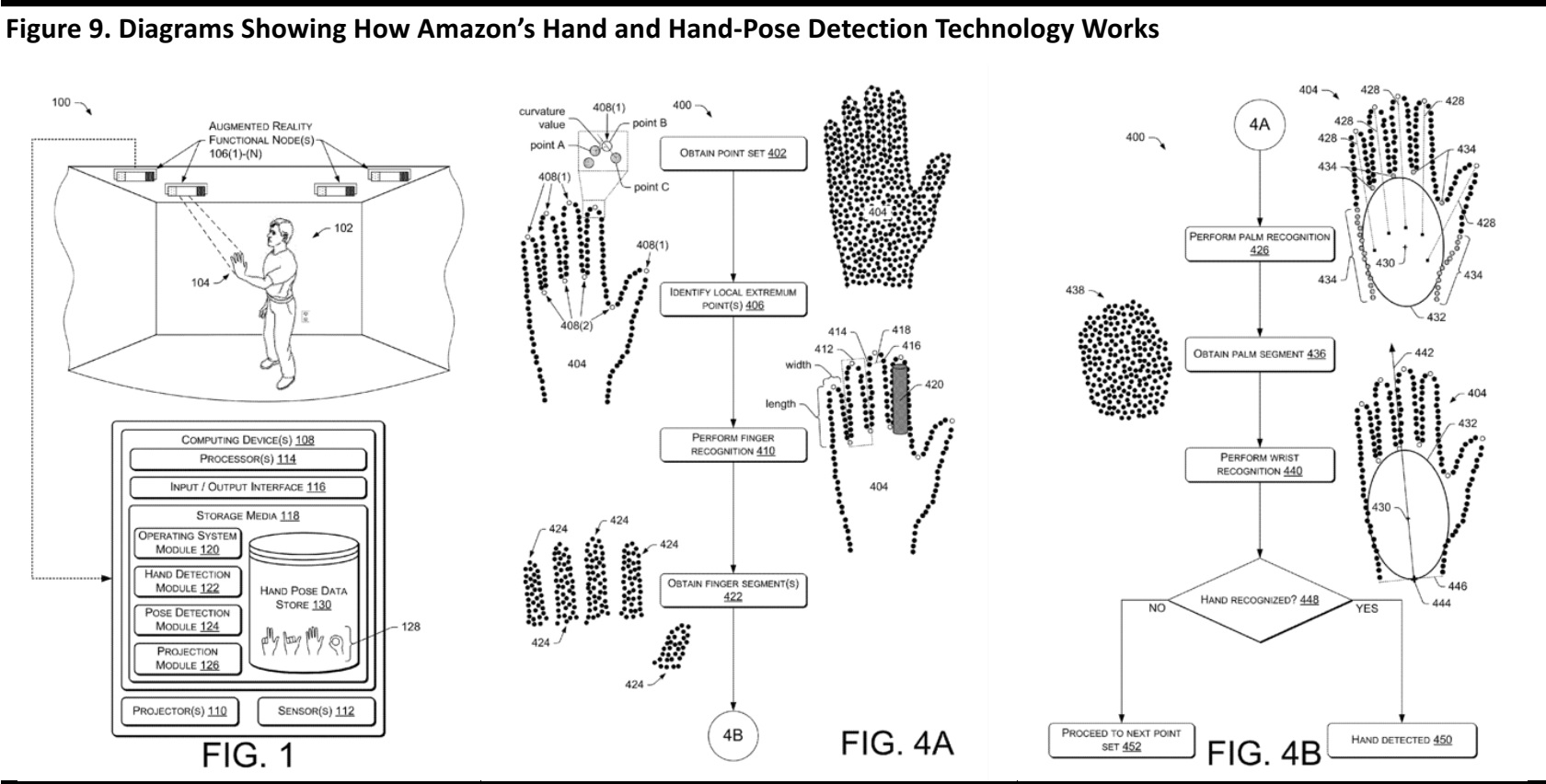 Source: Amazon/USPTO
Source: Amazon/USPTO
Fabric Storage Totes
Amazon has not only been patenting high-tech devices, complicated techniques, software and hardware, but also designs for objects as simple as fabric storage totes. The company received a patent on October 17, 2017, for fabric storage totes as well as for techniques for using them in a warehouse facility. The patent describes the construction of the totes, saying that they “may include a fabric base and side walls, with a hardened material support structure…[and] two handles made of a substantially hard material. The fabric totes may be accessed and transported, manually and/or mechanically, via interaction with the handles.” The accompanying drawings illustrate how these totes are meant to be used and serve as evidence that Amazon’s innovation efforts are not limited to sophisticated digital technologies.
 Source: USPTO
Source: USPTO
What We Think
Given the scale, depth and diversity of its innovative businesses, Amazon appears to be operating as a kind of hybrid e-commerce and technology firm. The company’s determination to innovate has been key to it staying ahead of consumer trends and developing cutting-edge concepts. Amazon’s most recent patents show that it is working to bring more experiences to its customers and to improve every aspect of the shopping journey, from trying on products to purchase to delivery.
As long as Amazon continues along this path, it will remain a threat to most retailers that focus largely on product assortment and creating a memorable in-store experience. To get out from under Amazon’s shadow, these competitors will need to begin to innovate and create their own proprietary technologies that help improve the customer experience.
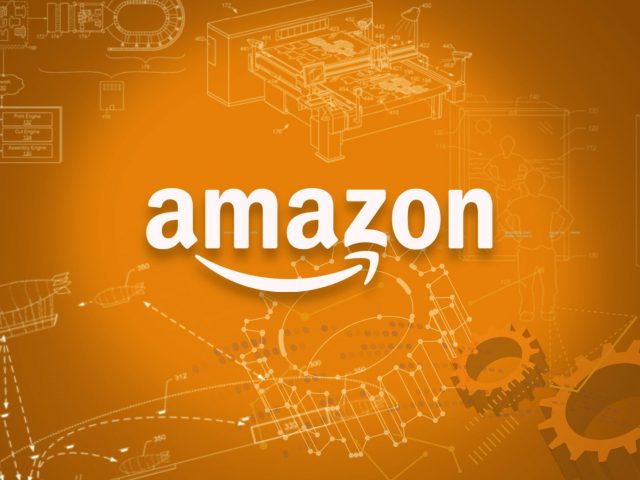
 As of January 1, 2018
Source: IFI Claims Patent Services/USPTO
As of January 1, 2018
Source: IFI Claims Patent Services/USPTO As of January 22, 2018
Source: USPTO
As of January 22, 2018
Source: USPTO Source: Bloomberg/S&P Capital IQ
Source: Bloomberg/S&P Capital IQ Source: Amazon/USPTO
Source: Amazon/USPTO Source: Amazon/USPTO
Source: Amazon/USPTO Source: Amazon/USPTO
Source: Amazon/USPTO Source: Amazon/USPTO
Source: Amazon/USPTO Source: Amazon/USPTO
Source: Amazon/USPTO Source: Amazon/USPTO
Source: Amazon/USPTO Source: USPTO
Source: USPTO